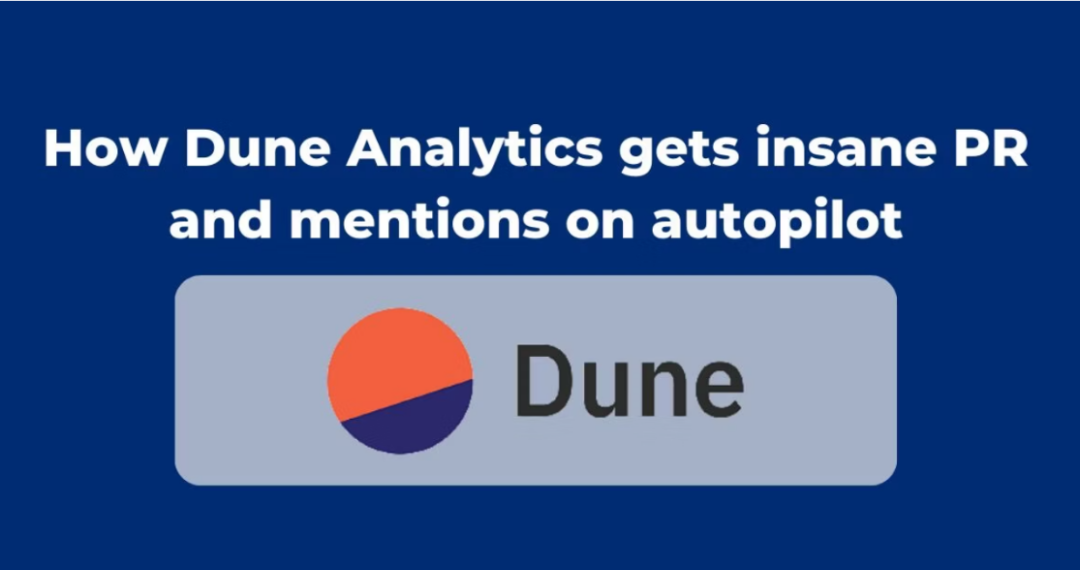
Author | Pete Boyle
Image | Sourced from the internet
When I started my market analysis, I focused on studying Web 2.0 brands in terms of Growth Models.
- Jackson Hole Central Bank Meeting Preview Overall Tone Is Hawkish, But US Stocks May Be Reaching a Turning Point.
- LianGuai Daily|US Department of Justice accuses Tornado Cash founder of money laundering and violating sanctions; Central African Republic passes tokenization law
- Immutable in the Cryptocurrency Winter Continuously Building Game Infrastructure
To be honest, I never lacked strategies for analysis.
In the Web3 field, the situation is much more difficult because many projects seem to be following the old “community-first” path.
Perhaps this is good, but many projects are not doing well and they are missing out on some truly easy opportunities.
Dune Analytics is one of the brands that has impressed me in the past few years.
I have had conversations with people who have ten years of experience in this field as well as newcomers, and they have all mentioned Dune.
What’s amazing about Dune is that they haven’t adopted the common methods in Web3, such as:
- Airdrops
- “Pay-to-follow” community growth
- Earning models using their own tokens (they don’t have tokens)
They have relied on many strategies that I consider to be traditional PR and brand awareness strategies, which easily dominate search engine result pages.
And all of this comes from the way they build their product.
It’s an incredible tool and one of the first tools that comes to mind when people talk about blockchain analytics.
So, how did Dune rise so quickly?
What is Dune Analytics?
Dune is a web-based application that allows anyone (with some SQL knowledge) to query blockchain data and create visualizations like the one below.
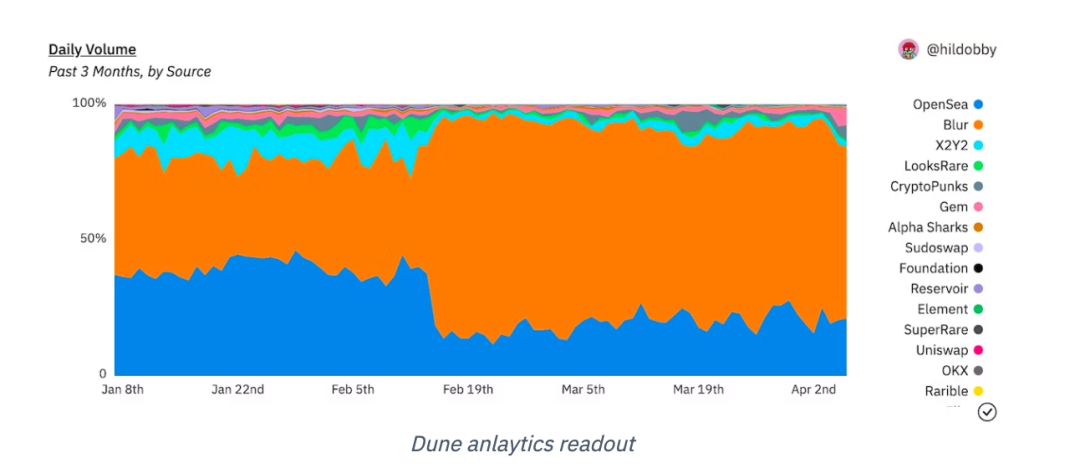
Some people even take the time to build complete dashboards that give others an overview of a project, a series, or even a subset of the industry, like this example about CEXs.
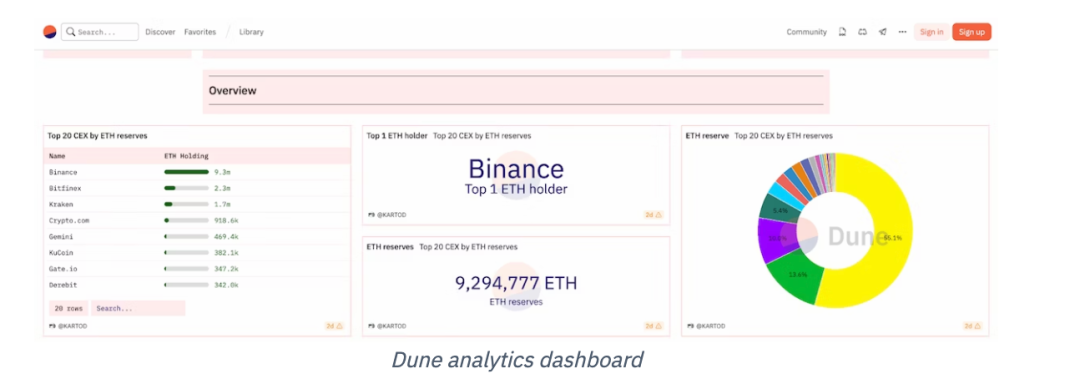
It’s a puzzling thing.
Dune didn’t spend money hiring people to build these dashboards, but there are countless new visualizations appearing every day, promoted by the people who create them (I’ll explain why they do this later).
In my opinion, they are more attention-grabbing than many other brands that offer data visualizations, such as Nansen.
The question is, how did they do it?
Let’s take a look together.
Dune’s Explosive Growth
Dune was founded in 2018.
But if you observe the existing analytics tools in the market, you’ll find that this platform didn’t really take off until around 2021.
SEMRush’s organic traffic took off from early 2022 (SEMRush’s data is low and is only considered organic traffic).

At the same time, they started generating backlinks.
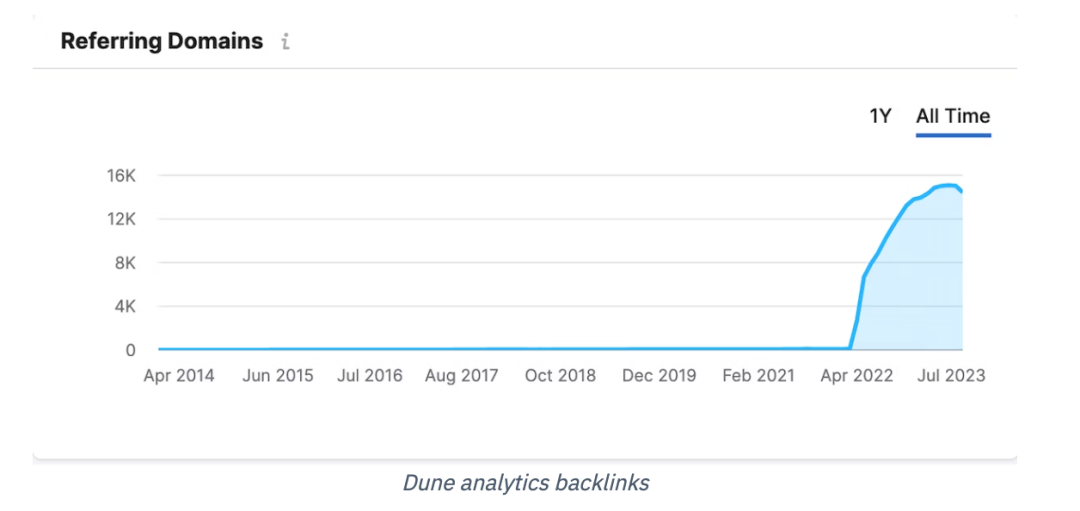
This seems to coincide with the Series A financing conducted by the brand in August 2021.
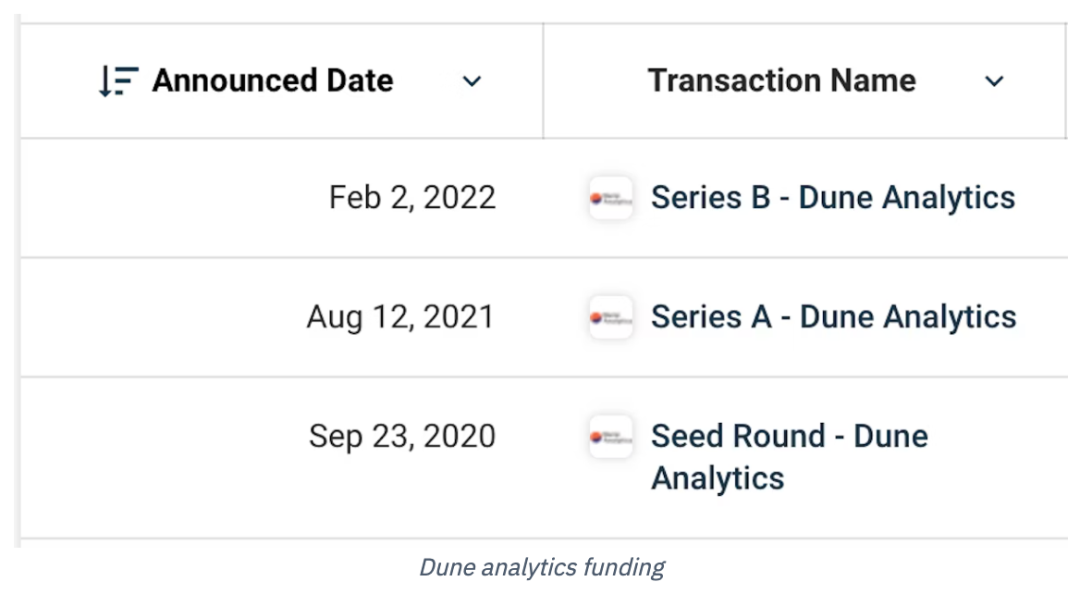
At the time, Dune seemed to suddenly appear in everyone’s field of view.
People talked about it, shared links, and went crazy creating visual effects.
For a while, Dune was everywhere.
Interestingly, very little of their traffic came from Google searches, most of it was direct visits.
In fact, I was also surprised that more of their traffic was not referral traffic (we will discuss this later).
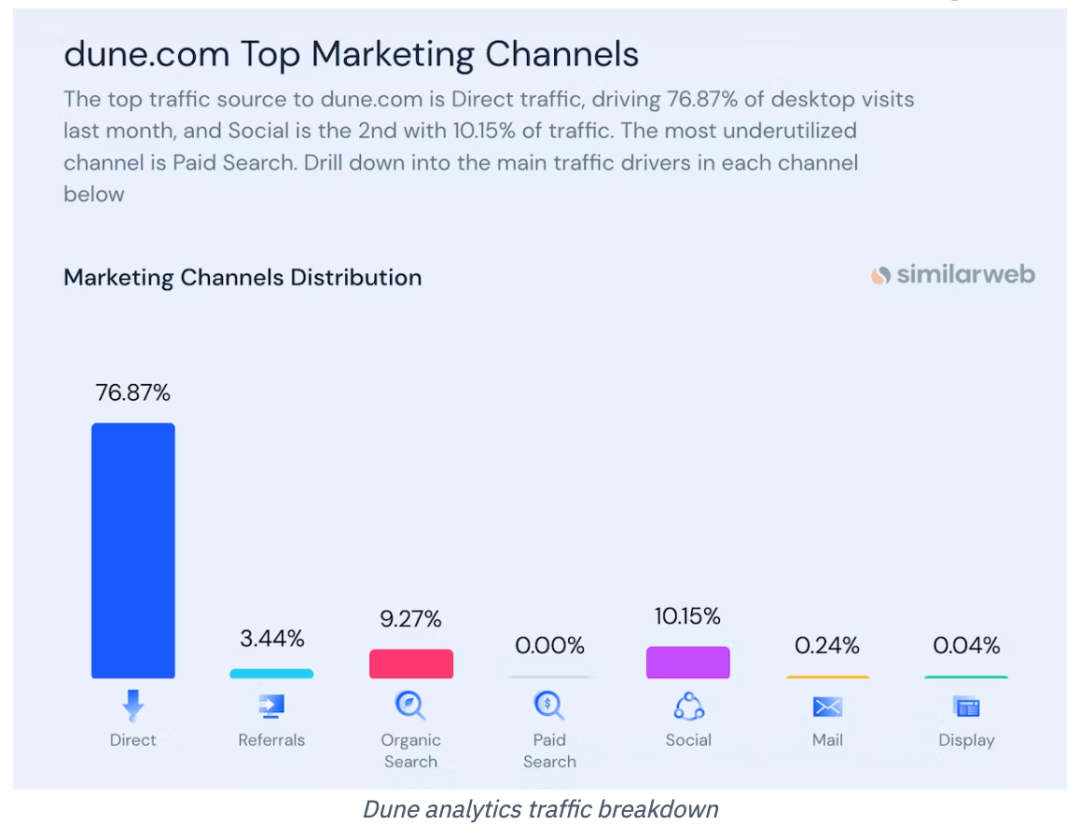
Very few brands can do this.
They have become synonymous with their category (blockchain analysis), and when someone needs visual analysis, they are usually the preferred service.
Therefore, they have gained a large number of users who don’t even need to search. They just need to go directly to the website.
I will analyze how they achieve this and explore several aspects that I think they can improve.
Dune is helpful for both the supply and demand sides of blockchain data visualization
That’s the essence of the problem.
Dune’s platform is doing a great job in helping both the supply and demand sides of data visualization.
Dune helps data scientists get attention and get paid work.
Dune also helps people who need analysis (venture capitalists and content creators) get detailed information about the entire industry.
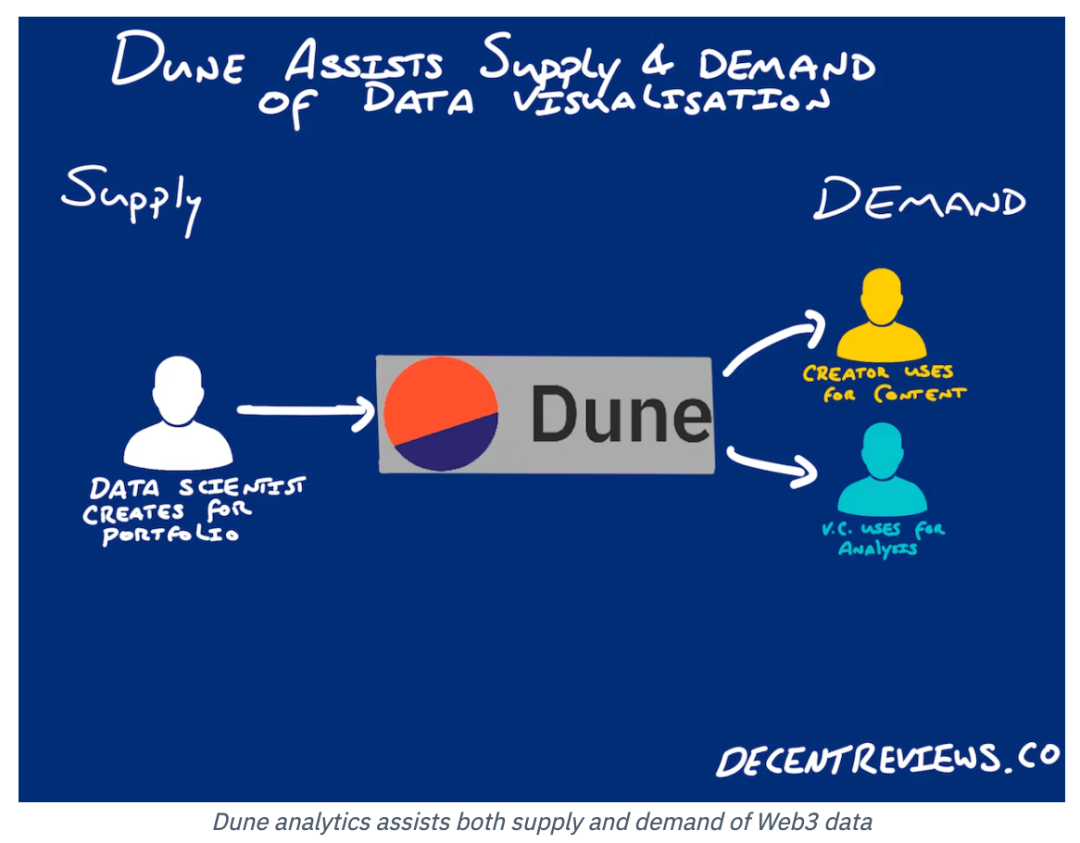
They position themselves in the middle of these two groups, creating products that are helpful to both.
As a result, everyone wants to talk about them.
Let’s delve into the details.
Demand – Supporting content creators, improving public relations and visibility
To be frank.
The best tools, projects, and products can help users achieve their goals. In most cases, they can make goal achievement faster, easier, or more cost-effective.
We are currently in the era of creators.
Everyone is creating content, from individuals looking to make some extra income to brands looking to attract thousands of new users.
Content is the means to achieve this goal.
It can be created through videos, blogs, podcasts, newsletters, or even social media accounts.
The amount of content produced is huge.
Moreover, if I really have to be demanding, a lot of the content is very ordinary, just noise.
The people creating this content are not necessarily experts (at least not yet). They just have enough motivation to invest time in constantly producing content.
Building an audience by providing summaries similar to those of other humans is a long and difficult process.
However, if you have unique insights, perhaps derived from data analysis, you will immediately stand out.
Opinions supported by data not only carry more weight, but can also attract attention through cool images, helping to explain various factors.
This is where Dune comes in.
Prior to the emergence of Dune, analyzing blockchain data was difficult for anyone other than the most professional technical personnel.
However, with Dune and some SQL knowledge, anyone can create simple charts or more detailed analysis dashboards.
As a result, various creators are referencing Dune in their works.
Brands and influencers use Dune to discuss project growth or interesting changes in the market.
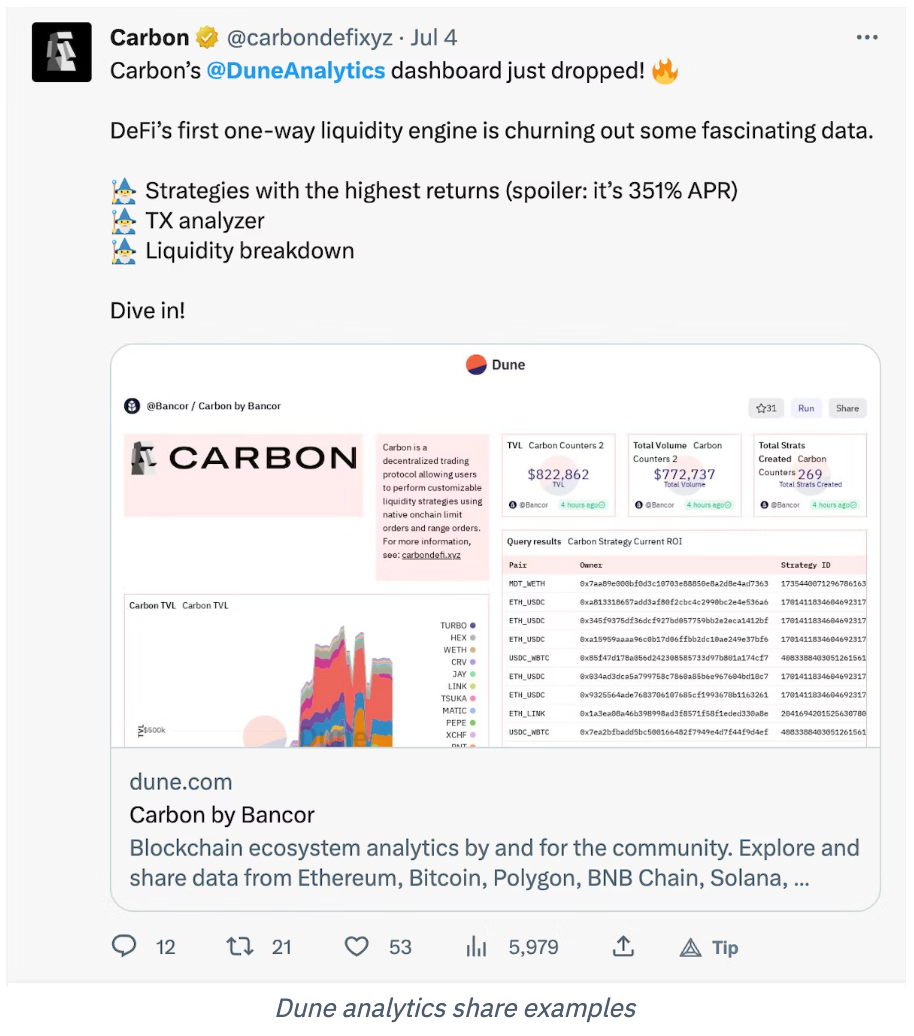
Large publications like Coin Telegraph, which have millions of readers, use Dune to enhance their coverage.

Dune also appears in video tutorials on Web3 analytics.
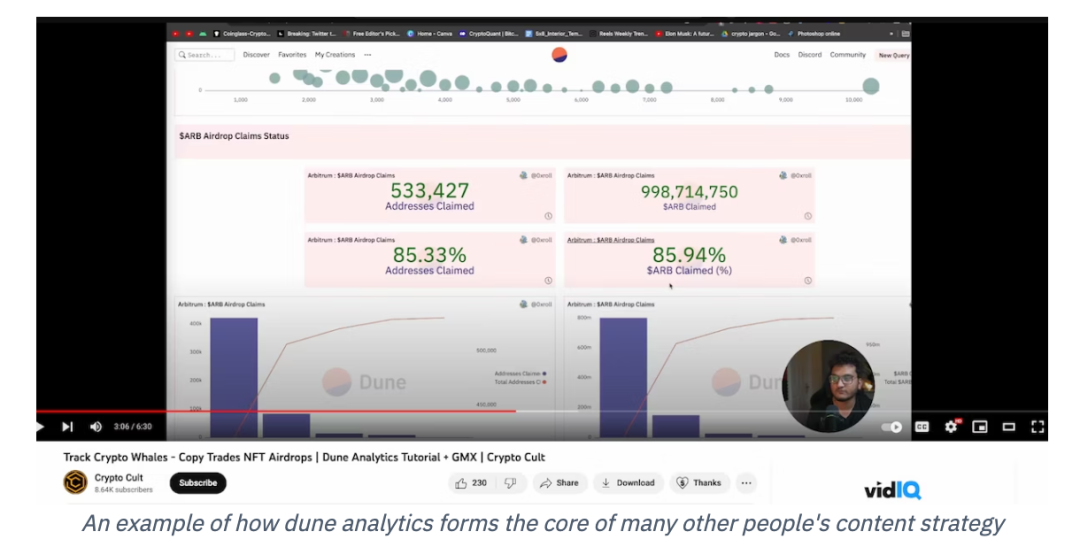
All these references not only expose Dune to a wider market, but also bring them backlinks, helping with their organic rankings on Google.
According to SEMRush data, Dune has about 3.5 million backlinks from over 14,000 domains pointing to its website.
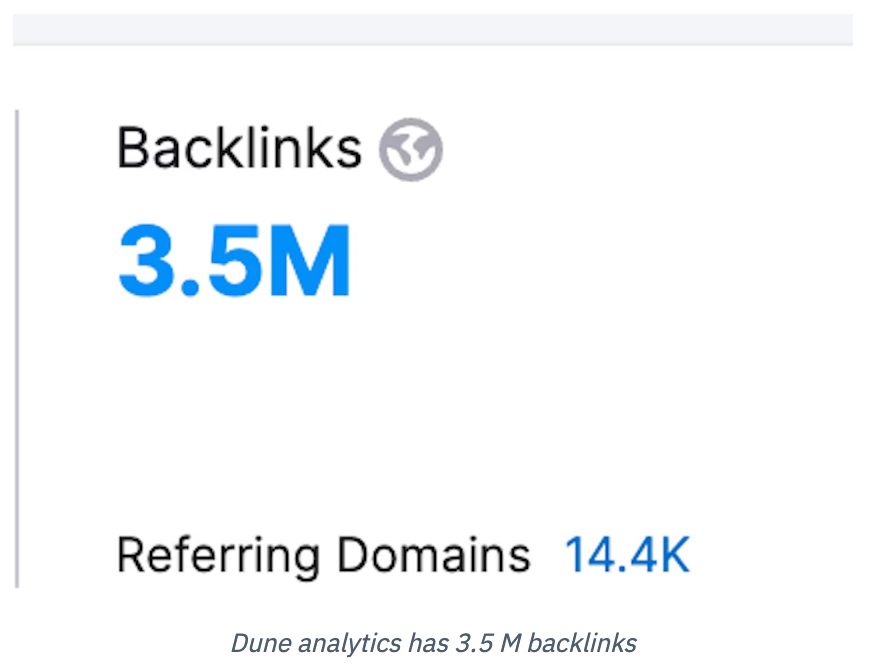
In essence, Dune has created a product that creators need to grow their businesses, and if they use this product, they must reference it.
The result is tremendous exposure and backlinks that help the brand grow.
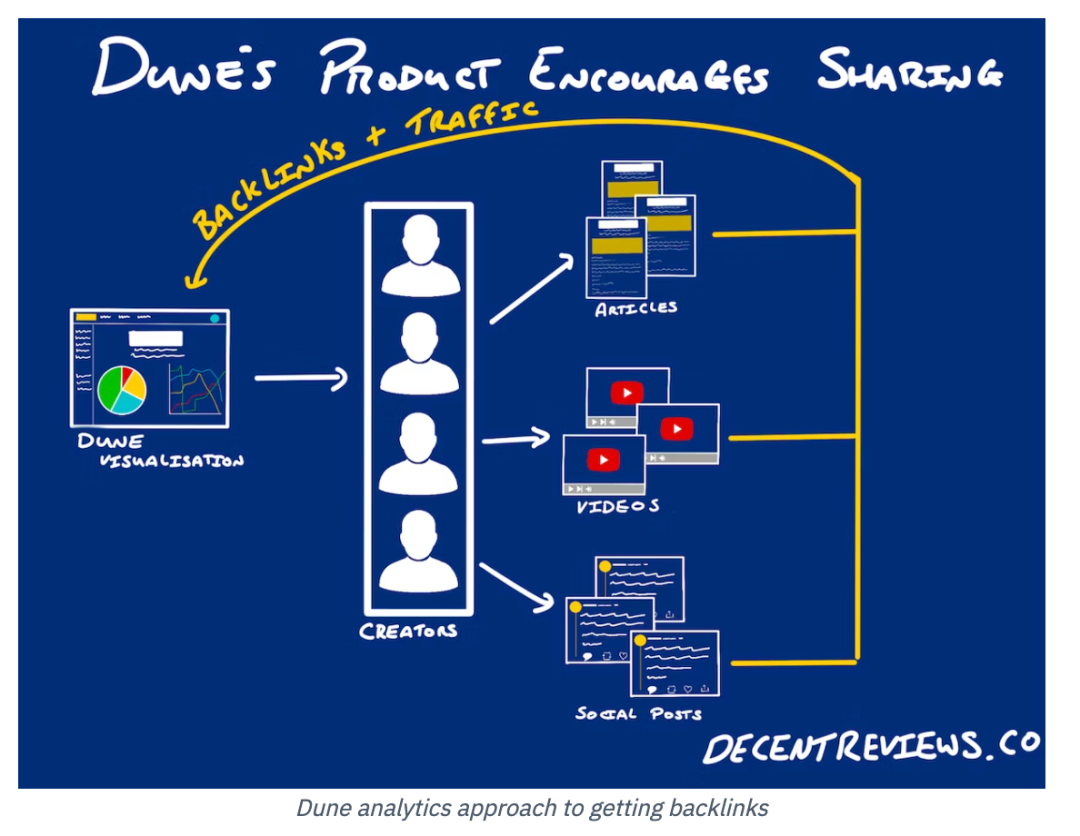
Supply – How Dune enables data scientists to create visual effects
When I started researching Dune, the first thing that came to mind was, “How do they get these people to create these visual effects?”
What I mean is, without visual effects, Dune would not receive attention and usage from the media.
These people are actually creating marketing materials for Dune.
But why would someone bother to learn how to use Dune?
Again, this boils down to Dune relinquishing control and allowing others to benefit from the product.
It’s hard to find a job as a data scientist. You need a specific set of skills and have to prove your abilities to potential employers.
In addition, data scientist positions are highly competitive and relatively well-paid. This means that brands looking to hire data scientists only need those who have been validated.
Dune provides an opportunity for newcomers in this field to showcase their skills and find jobs.
Anyone can create an account and start building dashboards for free on Dune.
Because public dashboards can be built for free, Dune actually becomes a portfolio for data scientists.
For example, it’s like:
- WordPress or Medium for writers (if you like Web3, it’s like Mirror.xyz)
- YouTube for video editors
- Figma for user experience designers
Aspiring data scientists can create dashboards to showcase their skills and use them to find jobs.
This is great because if someone’s visualization work gets picked up by well-known media outlets like CoinTelegraph, the creator can get a link, attracting potential clients.

But Dune goes even further.
They launched the Wizard program.
Those who are very proficient on Dune can become Dune Wizards and showcase their work.
They have a special category on the main search page.

As more and more people start seeing the work of Wizards, more and more brands will reach out to them for help in building their own dashboards, as mentioned in this interview with a Dune Wizard.

Dune also launched a job board to help these Wizards apply for and find jobs.
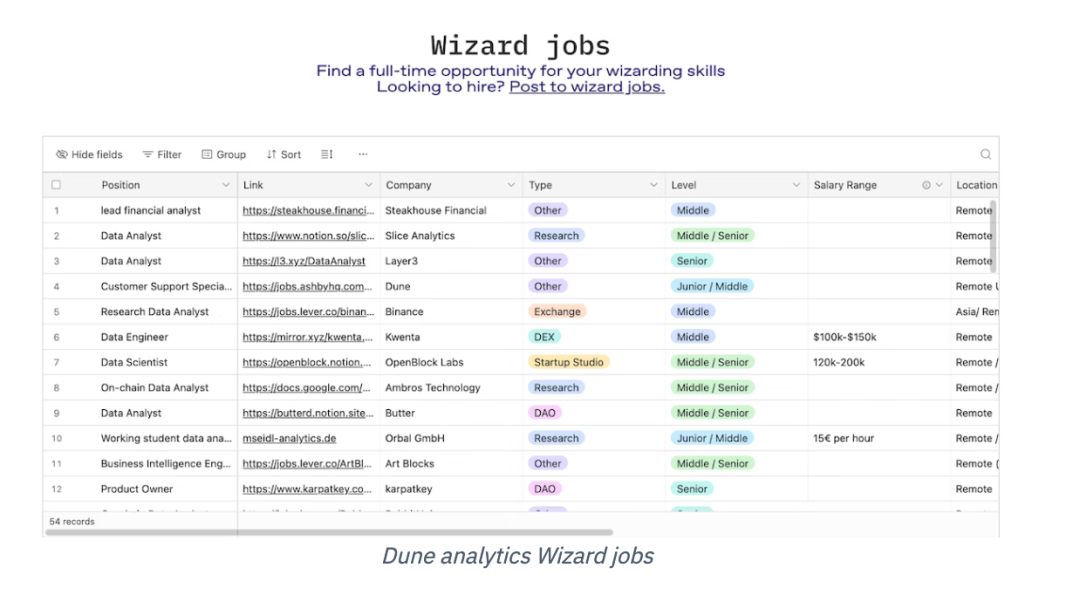
Some of these jobs pay six figures.
It’s great for beginners who want to understand visualized blockchain data.
But again, Dune is not the focus for these people.
They allow others to pursue their own goals using their product.
Blockchain data supply and demand “freely unite”
The whole approach of Dune is to provide tools for others to grow and achieve their goals, and this approach is very effective.
Dune is located at the fascinating intersection of three types of demand:
1. Data scientists – who want to build their own portfolios and find jobs;
2. Creators – who need data scientists to create more engaging content;
3. Institutions – who need reputable data scientists to help them understand their investments or their own development.
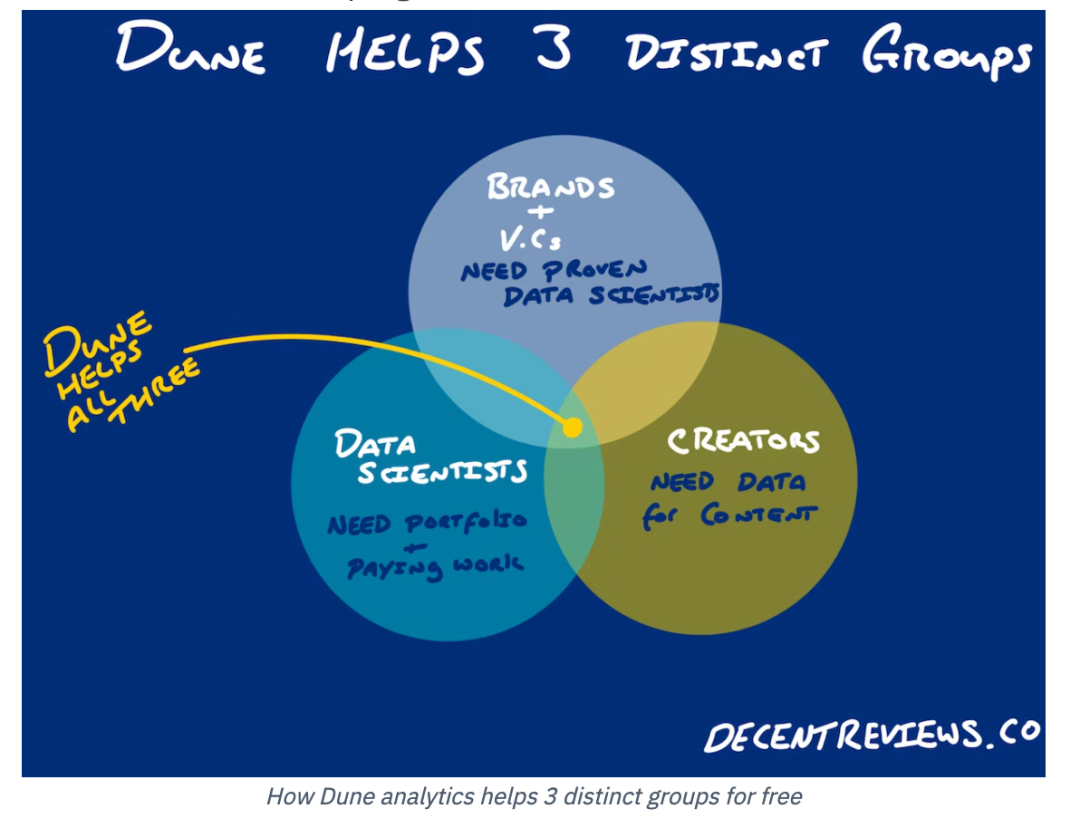
Very few brands can do this.
Most brands want their detailed data visualizations to be behind a paywall, accessible only to customers.
Other brands charge high fees, making it difficult for emerging creators to access these tools.
Then there are brands that are very focused on protecting their intellectual property and do not allow others to share their products.
Dune breaks all these trends.
Anyone can create visualizations for free and use them for free in any marketing material (with appropriate attribution).
At first glance, you might think Dune is just a tool for visualizing massive amounts of blockchain data, but it’s much more than that.
Dune is a matchmaking platform that provides opportunities for people who need data and valuable data for data scientists.
By helping everyone, they are also helping themselves.
But if everything is free, how do they help themselves?
Dune’s Revenue Model
While you can create dashboards for free and share visualizations created with Dune, they also have a paid plan.
They know that everyone wants (or needs) to make their data public to everyone.
Many projects require specific on-chain data analysis to help them understand how to develop as a brand. They need specific analysis for their internal processes.
Dune offers a paid plan.
Institutions can sign up for the paid plan to help them with internal data analysis. This is ideal for projects that have a large amount of on-chain data to organize or for venture capital firms that need to understand the development of projects.
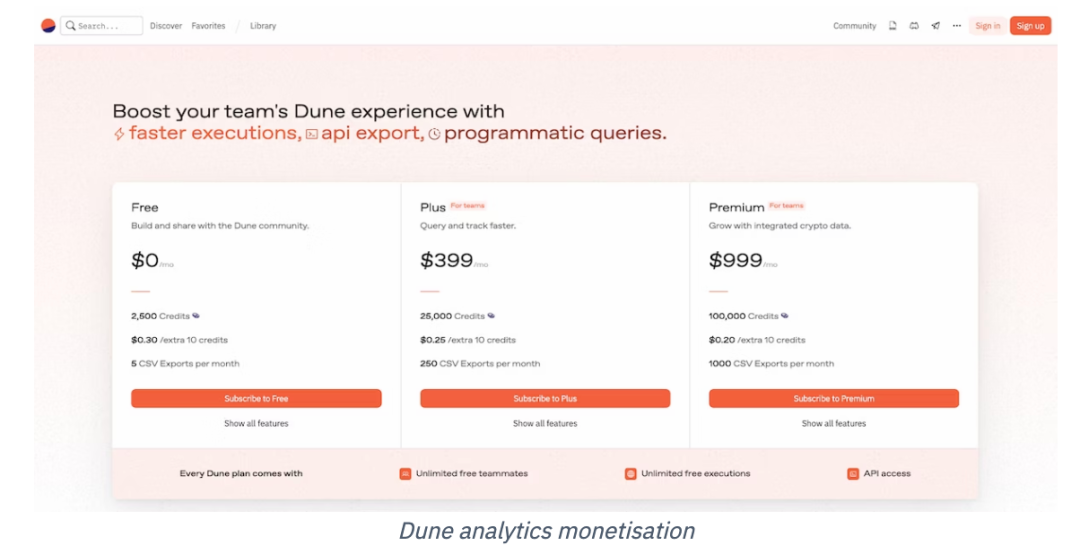
I like this model because you essentially get a full product demo for free.
Anyone considering purchasing a premium plan can access Dune and see what kind of data insights they can generate.
If they like what they see, they are more likely to sign up for the paid plan. If they need help, they can directly find it on the Wizards portal.
Areas I think Dune is missing
I’m surprised that Dune hasn’t gained more organic traffic. If they take notice of this, they could greatly increase their traffic.
Their domain authority is high. As of the writing of this article, according to Ahrefs data, their DA value is 78.
If you don’t know, DA is a third-party metric that evaluates the authority of a website. Generally speaking, the higher the DA value (on a scale of 100), the higher its ranking in Google.
A DA of 78 is very high in authority.
However, organic traffic is very low. SimilarWeb indicates that organic traffic accounts for less than 10% of the total traffic to the website.
Why?
Many visualized data is not optimized for Google search.
And I don’t recommend changing them either. I think they are already good as they are.
So what does Google index for Dune? They tend to index many creator pages.

In fact, I can’t imagine how much exposure these pages would have in search results.
If I were a consultant for Dune and they wanted to increase traffic, I would try to use the platform to create data outputs that are relevant to what people search for.
Here are some basic Crypto search keywords. This is just a small snippet.
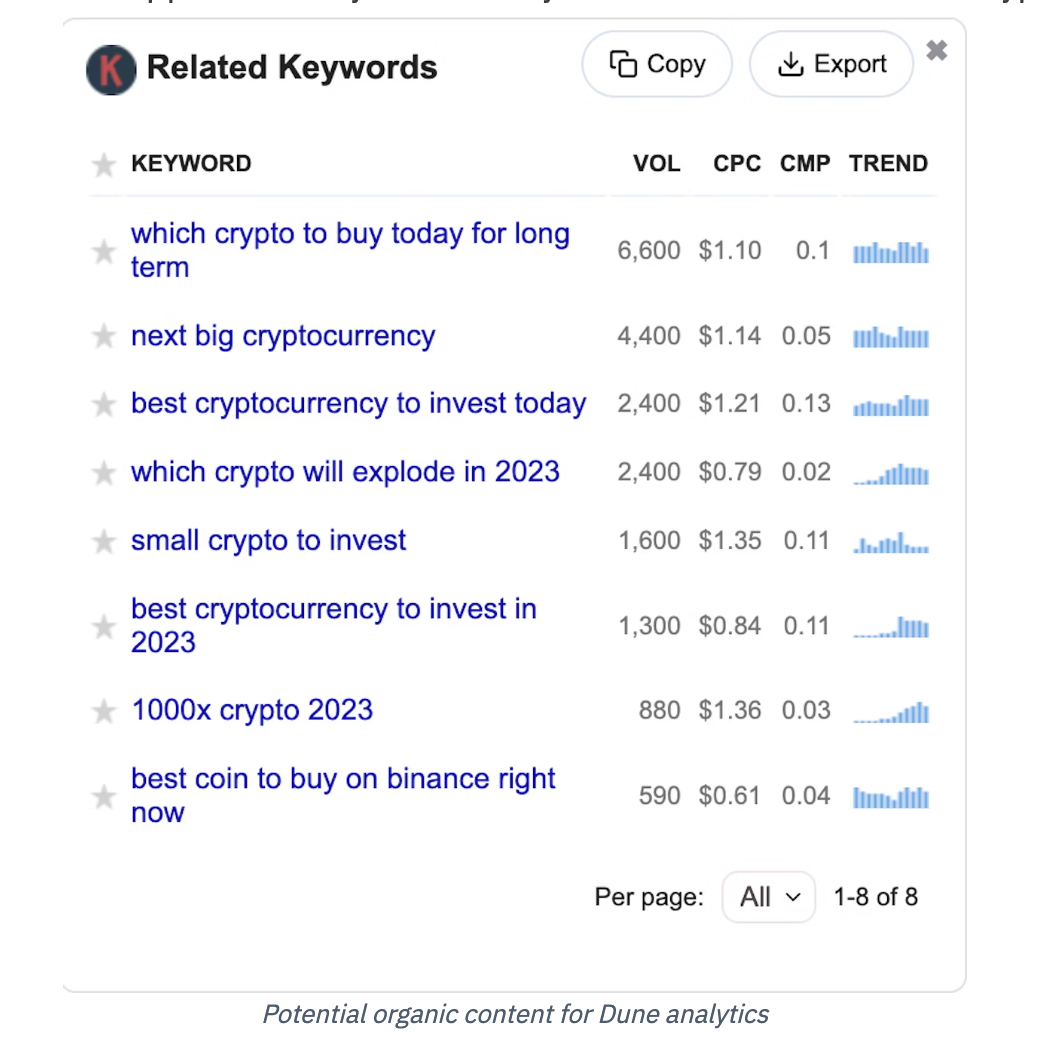
There are about 20,000 searches per month here, and the competition level is relatively low (CMP on a scale of 0-1, with 1 indicating the most competitive).
With Dune’s DA, they can create articles that are updated monthly and rank quite high in Google.
They have the following advantages:
- Being recognized as an authority;
- Having direct access to data;
- Having an established audience.
They can easily create articles targeting high search volumes and leverage their own data to create unique content.
In the above scenario, caution should be exercised to avoid providing “financial advice,” but it’s easy to find an angle to avoid this issue.
For example, instead of focusing on an article titled “Which long-term Crypto should you buy today,” an article titled “Top Crypto with the highest trading activity in the past X months” can be created.
Optimization can still be done using the main keywords listed in the image, but specific investment statements should be avoided.
I imagine they could easily increase their number of visitors by hundreds of thousands each month by handling this content.
Especially in the current situation where SEO methods for Web3 are relatively weak.
Summary of Dune
I believe the success of Dune can be attributed to two key factors:
1. Having an outstanding product that caters to multiple groups;
2. Allowing people to use their product for free, thus promoting free public relations.
While this in itself is not a marketing strategy, the way they have built it has made Dune well-known.
They have built their business with the goal of helping others. They haven’t put themselves at the center of everything, but rather found themselves there, thanks to their generosity.
This is a true Web3 method.
I do believe they can do more in terms of traffic, and I hope their monetization model is sufficient to keep them vibrant during the development process.
Original article written by Pete Boyle, Chinese version compiled and translated by the Chain Market team. English copyright belongs to the original author, please contact the translator for Chinese reposting.
Like what you're reading? Subscribe to our top stories.
We will continue to update Gambling Chain; if you have any questions or suggestions, please contact us!